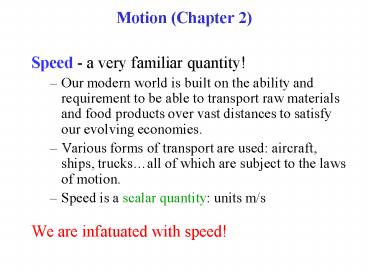Motion (Chapter 2) - PowerPoint PPT Presentation
Title:
Motion (Chapter 2)
Description:
So the speed of the car is constant but its velocity is changing! ... When a car, aircraft or elevator accelerates, we feel a force on our body. ... – PowerPoint PPT presentation
Number of Views:14
Avg rating:3.0/5.0
Title: Motion (Chapter 2)
1
Motion (Chapter 2)
- Speed - a very familiar quantity!
- Our modern world is built on the ability and
requirement to be able to transport raw materials
and food products over vast distances to satisfy
our evolving economies. - Various forms of transport are used aircraft,
ships, trucksall of which are subject to the
laws of motion. - Speed is a scalar quantity units m/s
- We are infatuated with speed!
2
Motion
- Typical speeds
- walking few km/hr
- ship 30 km/hr
- car 100 km/hr
- jet aircraft 800 km/hr
- fastest car 1,200 km/hr (speed of sound)
- research aircraft 4,800 km/hr
- orbiting space craft 25,000 km/hr (7 km/ sec)
- speed of light (c) 300,000 km/sec (3 x 108
m/s) - c is over 40,000 times faster than current space
craft speeds.
3
Average Speed
where S av. speed D distance
t time
Speed is a scalar quantity, and is usually
measured in units of m/s or km/hr.
Distance traveled can be a lot longer than the
direct (line-of-sight) path.
20 mph 32 km/hr 9 m/s
40 mph 64 km/hr 18 m/s
60 mph 97 km/hr 27 m/s
Typical values
80 mph 130 km/hr 36 m/s
100 mph 160 km/hr 45 m/s
4
Instantaneous Speed
- At any given time the instantaneous speed of a
vehicle will be different from its average speed. - Instantaneous speed tells you the speed at that
moment in time. - A speedometer measures instantaneous speed.
- In contrast, average speed helps tell us the
length of a trip but gives no information on the
variations in speed during the trip.
5
Graphic example
encountered a slower vehicle
constant speed
speed (km/hr)
de-acceleration to stop
rapid acceleration to high speed
breaking
accelerating
start
stop
Time (min)
(or average speed average of all instantaneous
speeds)
6
Summary
- Average speed Average rate at which distance is
being covered. - Instantaneous speed Rate distance is covered at
a given moment in time.
7
Velocity
- Speed and velocity are NOT the same!
- Velocity is a vector and includes direction in
the description of motion, eg. 10 m/s due S.
V2
Ball bounced against a wall
V1
wall
The magnitude of the velocity (speed) after
impact may be similar to before the impact but
the direction is quite different, therefore the
velocity is different!
To change the velocity a force had to be exerted
on the ball (by the wall in this case).
8
Car Turning a Bend
B
- Car is traveling at a constant speed around the
bend.
- But its direction of motion is continuously
changing from A?B.
V1
So the speed of the car is constant but its
velocity is changing!
A
- The change in velocity implies a force acting on
the car to change its direction.
- Frictional force exerted by road on the car tires
allows the car to change direction (if low
friction, cannot change direction very easily eg.
skidding on ice.)
9
Instantaneous Velocity
- Measures the instantaneous speed and its
direction at that moment in time. - Instantaneous velocity provides a more scientific
description of motion as the velocity vector may
change in magnitude or direction with time. (eg.
driving your car home!) - Summary
- Velocity is a vector quantity describing the
speed and direction of motion. - A force is required to change either the
magnitude or the direction of the velocity
vector. - Instantaneous velocity is important for our study
of motion.
10
Acceleration (vector quantity)
- Like speed (but perhaps not velocity), we are
very familiar with the term acceleration. - When a car, aircraft or elevator accelerates, we
feel a force on our body. - The acceleration causes a change in the velocity
of the vehicle (eg. in its magnitude, direction
or both). - Acceleration is the rate of change of velocity
(not speed) with time. - Acceleration is the key to Newtons Laws of
motion and is vital to understanding our every
day world. - Average acceleration
?v
a
or
?t
11
Example
- Rocket at lift off accelerates uniformly up to a
velocity of 1,000 km/hr in 10 sec. Determine a.
v1 0 v2 103 km/hr or
- Units m/s2 meter per second per second.
- i.e The rockets velocity (measured in m/s) is
increasing at a rate of 27.8 m/s every second.
- Very fast accelerations can be measured in km/s2.
- So if the velocity is constant there is no
acceleration.
12
Questions
- Large velocities are associated with large
accelerations? - FALSE!
- A vehicle starting from rest often has its
largest acceleration while its velocity is still
low? - Example truths
- The velocity of a vehicle accumulates with time
as it continues to accelerate. (So time is
important to achieve large velocities from modest
accelerations). - If the velocity is constant there is no
acceleration. (ie. a 0). - Key CHANGE!
- Applied force causes a change in acceleration
which produces a change in velocity! - Think about this over the weekend!
TRUE!
13
Next Class Monday 1030 am First Laboratory
demo Tuesday 15 Jan (ESLC Room 053 at 130
pm) Read All Chapter 2































![Chapter [x] Jeopardy PowerPoint PPT Presentation](https://s3.amazonaws.com/images.powershow.com/7696098.th0.jpg?_=20160324128)